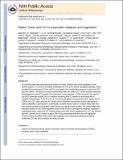Redox, haem and CO in enzymatic catalysis and regulation
Author(s)
Ragsdale, Stephen W.; Yi, Li; Bender, Güneş; Gupta, Nirupama; Kung, Yan; Yan, Lifen; Stich, Troy A.; Doukov, Tzanko I.; Leichert, Lars; Jenkins, Paul M.; Bianchetti, Christopher M.; George, Simon J.; Cramer, Stephen P.; Britt, R. David; Jakob, Ursula; Martens, Jeffrey R.; Phillips, George N.; Drennan, Catherine L; ... Show more Show less
DownloadDrennan_Redox haem.pdf (1.402Mb)
OPEN_ACCESS_POLICY
Open Access Policy
Creative Commons Attribution-Noncommercial-Share Alike
Terms of use
Metadata
Show full item recordAbstract
The present paper describes general principles of redox catalysis and redox regulation in two diverse systems. The first is microbial metabolism of CO by the Wood–Ljungdahl pathway, which involves the conversion of CO or H2/CO2 into acetyl-CoA, which then serves as a source of ATP and cell carbon. The focus is on two enzymes that make and utilize CO, CODH (carbon monoxide dehydrogenase) and ACS (acetyl-CoA synthase). In this pathway, CODH converts CO2 into CO and ACS generates acetyl-CoA in a reaction involving Ni·CO, methyl-Ni and acetyl-Ni as catalytic intermediates. A 70 Å (1 Å=0.1 nm) channel guides CO, generated at the active site of CODH, to a CO ‘cage’ near the ACS active site to sequester this reactive species and assure its rapid availability to participate in a kinetically coupled reaction with an unstable Ni(I) state that was recently trapped by photolytic, rapid kinetic and spectroscopic studies. The present paper also describes studies of two haem-regulated systems that involve a principle of metabolic regulation interlinking redox, haem and CO. Recent studies with HO2 (haem oxygenase-2), a K+ ion channel (the BK channel) and a nuclear receptor (Rev-Erb) demonstrate that this mode of regulation involves a thiol–disulfide redox switch that regulates haem binding and that gas signalling molecules (CO and NO) modulate the effect of haem.
Date issued
2012-06Department
Massachusetts Institute of Technology. Department of Biology; Massachusetts Institute of Technology. Department of ChemistryJournal
Biochemical Society Transactions
Publisher
Portland Press
Citation
Ragsdale, Stephen W., Li Yi, Güneş Bender, Nirupama Gupta, Yan Kung, Lifen Yan, Troy A. Stich, et al. “Redox, haem and CO in enzymatic catalysis and regulation.” Biochemical Society Transactions 40, no. 3 (June 1, 2012): 501-507.
Version: Author's final manuscript
ISSN
0300-5127
1470-8752